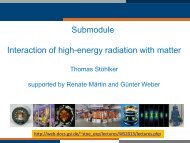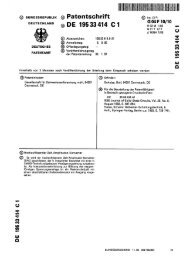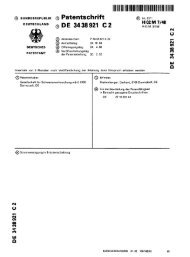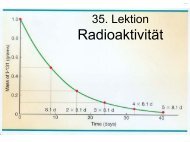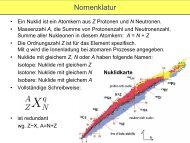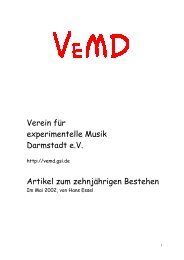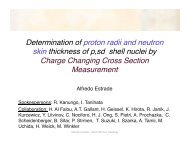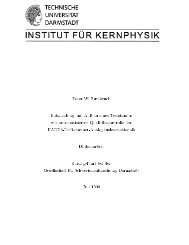doctoral thesis
doctoral thesis
doctoral thesis
You also want an ePaper? Increase the reach of your titles
YUMPU automatically turns print PDFs into web optimized ePapers that Google loves.
6 CHAPTER 1. INTRODUCTION<br />
more than 0.5 mm from the collision point before they decay. In the case of a colliding<br />
beam experiment they do not even have time to escape from the beam pipe. They can<br />
only be detected by extrapolating the very precisely measured tracks of the more stable<br />
decay products to the secondary vertex (displaced vertex), where they decayed, close<br />
to the collision point 1 . From the remaining 15 particles the following eight (plus the<br />
corresponding antiparticles) are by far the most frequent ones:<br />
electrons, muons, photons, charged pions,<br />
charged kaons, neutral kaons, protons and neutrons.<br />
This leads us to a very basic insight:<br />
The task of modern high energy physics detector systems is to identify eight different<br />
particles (and the corresponding antiparticles) that are crossing the device and<br />
to measure their momenta and/or energy. The same task is repeatedly implemented in<br />
similar ways in all high energy physics experiments.<br />
Fig. 1.2 shows the basic setup of many modern high energy physics experiments.<br />
The reason that detectors are divided into many components is that each component<br />
tests for a special set of particle properties. These components are stacked such that all<br />
particles will go through the different layers sequentially. We summarize the different<br />
tasks of the detector subsystems:<br />
Tracking Chambers: Directions, momenta, and signs of charged particles have to be<br />
measured. Finely subdivided tracking detectors are used to reconstruct charged<br />
particle trajectories. A magnetic field causes the trajectories to bend in circular<br />
paths: the radius of each circle determines the momentum, and the ’bending<br />
direction’ the sign of charge.<br />
Electromagnetic Calorimeter: The energy carried by electrons and photons is measured<br />
by the electromagnetic calorimeter. It is generally subdivided into segments<br />
that absorb the energy of incident electrons and photons, and produce<br />
signals proportional to that energy.<br />
Hadronic Calorimeter: The energy carried by hadrons (protons, pions, neutrons,<br />
etc.) is measured by the hadronic calorimeter. It detects hadronic showers in a<br />
similar way as the electromagnetic calorimeter detects electromagnetic showers.<br />
The hadronic calorimeter is always downstream (outside) of the electromagnetic<br />
calorimeter, due to the much larger interaction length of hadrons.<br />
1 The identification of such a displaced vertex can be used for the tagging of events (τ-, D- or Btagging)<br />
or even for triggering like in the LHCb experiment at CERN [13, 14].



